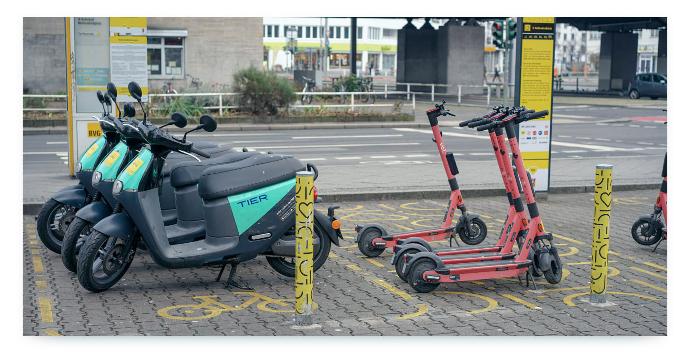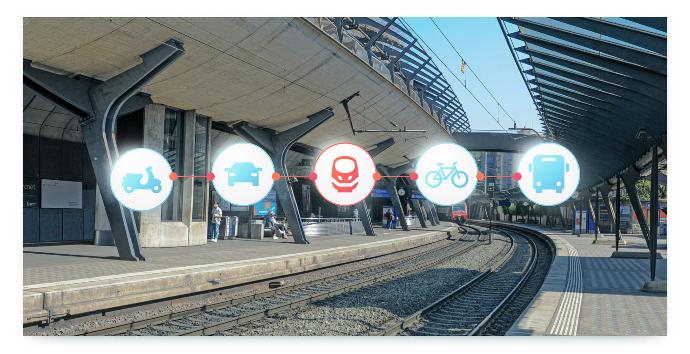For the mobility revolution to succeed, new solutions are needed. One of them is mobility stations, or mobility hubs. These are places where different mobility services come together to give people options on how to get around from here. With the help of these hubs, crowded streets, traffic jams and lack of parking spaces in cities should soon be a thing of the past. Can this work? And which locations are suitable as mobility hubs?
What is a Mobility Hub?
A mobility hub is a station or hub where diverse mobility offerings come together in one publicly accessible location - including public transit with trains and buses, car sharing, rental cars, shared micro mobility with bikes and scooters, ferries if applicable...
The rental car provider and the bus stop at the airport basically already form a mobility hub, as does the car-sharing station in front of the train station. But the trend today goes beyond that. Mobility stations are being set up in a targeted manner and cover as diverse a range as possible to enable multimodal mobility.
The 3 evolutionary stages of Mobility Hubs
Stage 1: Isolated offers for connecting mobility at train stations or airports (past and present).
Seamless Mobility: A Win for all Stakeholders
The great promise of mobility hubs is that users can seamlessly switch from one mode of transport to another. They can drive to the station in their own car, park there and then take the train into the city. Or that they reach the station by bus, rent a bike there and continue cycling. An even longer chain is also possible - perhaps there are even two or more mobility stations along the entire route where the means of transport is changed.
Who operates mobility stations - and why?
Even if the individual mobility services are usually operated by different companies and transport companies, there needs to be an authority that provides the space, takes care of the development and maintenance, and coordinates the overall service. In principle, this can also be private-sector companies, but it is usually local governments or municipal transport companies.
Cities have the task of planning, improving and regulating local traffic. On the one hand, they are subject to public pressure to drive forward the mobility revolution and reduce traffic-related pollutant emissions and local particulate matter pollution. On the other hand, they also have a self-interest in shifting the focus from private motorized transport to other, more environmentally friendly mobility options - and thus counteracting overcrowded roads and the lack of parking spaces. Easing the burden on both moving and stationary traffic improves the quality of urban life and at the same time increases the safety of cyclists and pedestrians.
Local transport companies can also benefit from operating mobility hubs. By supplementing their own core business with alternative mobility services, these are perceived as more attractive and attract more users who can now comfortably cover the "last mile". Transport associations are undergoing a transformation into integrated providers of local mobility. Of course, they also enjoy positive marketing effects from operating a mobility station - at least if it is well received by the population.

The proven concept of multimodal mobility
The combination of different means of transport has long been established in the field of logistics. To bring a good from the place of production to the final place of sale or use, one means of transport is rarely sufficient. Especially when it comes to imported goods. In this case, transport chains often consist of transporters, ships or airplanes, freight trains or trucks, and even delivery vans.
The only thing that is really new is the approach of increasingly applying this concept to urban passenger transportation. For good reason: If people are to increasingly do without their private cars in order to protect the environment and live a quality life in the city, they will rarely be able to avoid a combination of different forms of mobility. And this should be as attractive and accessible as possible.
Multimodal mobility only becomes a real option if switching between modes of transport does not take up too much time. Especially in urban structures, getting around quickly becomes an additional stress factor and time robber between everyday stresses and appointments. It is true that traveling by private car also costs time, especially in traffic jams or while looking for a parking space, but here the comfort factor, flexibility and perceived freedom still play a major role for many. However, people are only truly free in the way they get around when there are low-threshold offers that go beyond their own car.
That's why it's important to make the interlinking of mobility services as seamless as possible - at attractive hubs, the mobility hubs. In times when mobility is increasingly viewed as a service (= Mobility as a Service, MaaS), users attach great importance to always being able to choose the solution that makes the most sense at any given time.
At the hubs, there is no need to travel long distances to switch, and a variety of options are available.
This also ensures greater reliability, which is lacking in many places with regard to public transportation. If one of the means of transport at a mobility station breaks down or is unavailable for some other reason, there are alternatives that can be used at the same location.
Excursus: Digital Mobility Hubs
Life has long since moved beyond the offline world, and smartphones have become personal everyday companions. People also rely on apps when it comes to mobility - because digital map services always show the most sensible route and can already combine different forms of mobility.
A logical step is therefore to map physical mobility stations digitally as well. This can be done by so-called aggregators, such as Jelbi. Jelbi is operated by Berliner Verkehrsbetriebe (BVG), which operates mobility hubs throughout the capital as well as an app of the same name.
In such aggregator apps, various mobility services and providers are not only visible, but can also be booked, either directly or via single sign-on. This means that users do not have to register with all the services individually, nor do they have to laboriously find out the best route option in each case themselves. Instead, they get quick and easy access to available vehicles and public transportation.
Where do Mobility Hubs Make Sense?
First of all, mobility hubs make sense where mobility services are already available. These are, for example, central transportation hubs such as train stations, (long-distance) bus stations, larger train stops or airports. These locations already have an existing frequency of users, which means that it can be assumed that a mobility station will be used to the desired extent at an early stage.
In addition, mobility stations close to people's homes are recommended - because ultimately, mobility begins on one's own doorstep. Stations can be set up in busy neighborhoods, for example by redesigning urban parking areas. They can also be planned and implemented in new residential construction projects.

In terms of residential proximity, the outskirts of the city should not be neglected either: For example, people who live outside and commute into the city can park their car at the hub and travel from there to the center using alternative means of transportation. Depending on regional structures, comparatively simple "Park & Ride" or "Park & Share" places may be sufficient at first, where the offer can still be expanded step by step in the future.
Another place where mobility stations could find the initial appeal they need is in the parking areas of commercial properties. These are frequented every working day anyway and have the required space. If you want to think a little more into the future, you might also consider redesigning gas stations: Since these need new strategies anyway due to the drive turnaround that is already underway, one solution may be to reduce the number of gas pumps and use the existing infrastructure to create a more comprehensive mobility station.

Thinking Ahead: Visionary Mobility Hubs
Thinking even further into the future, mobility hubs can become elementary meeting points and crossroads of public life - so to speak, the third stage in the evolution of mobility hubs (see infobox above).
The various mobility offerings are rounded off with supplementary services such as filling stations, charging stations, car washes and repair services. Toilets are also part of the equipment, as are parcel stations, shopping facilities, gastronomy and co-working spaces. The areas are greened, have seating for resting and invite people to linger.
This means that changing vehicles and the associated waiting times can be put to good use - depending on individual needs. Anyone who wants to can do the weekly shopping in the connected supermarket. Someone else takes the time for a coffee break, a third person answers a few e-mails and others arrange to have lunch together. It is possible to arrive with one's own e-car, connect it to the charging station, cover the rest of the way with alternative means of transport and pick up the now charged car on the way back.
Mobility options are no longer just seamlessly connected to each other, but also bridge the gap between pure transportation and the diverse demands of everyday life. What used to rob time and cause stress is now everything from a needed break to take a breath, to a place to do errands, to a center of encounter. Mobility is becoming what it has always been: an integral part of life.




